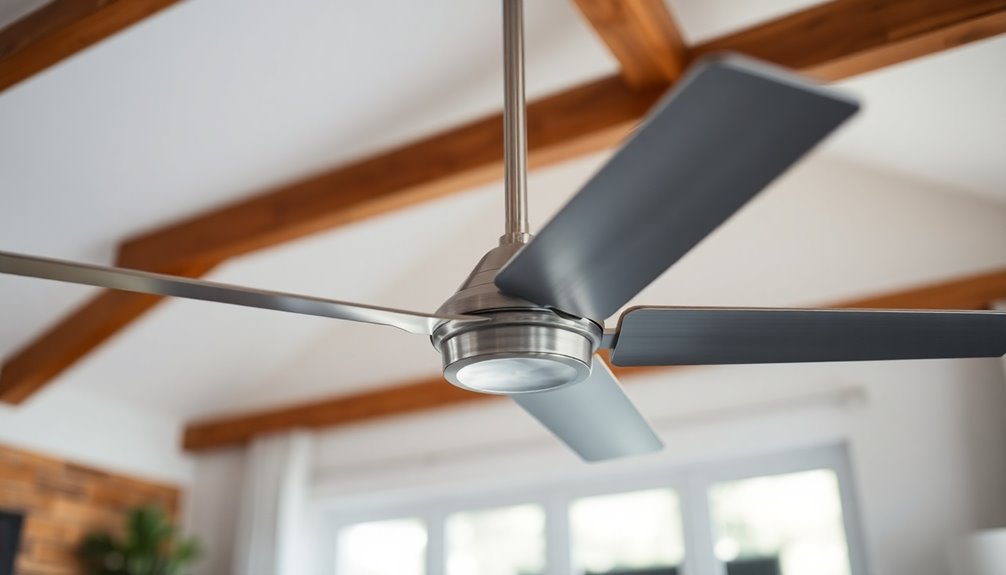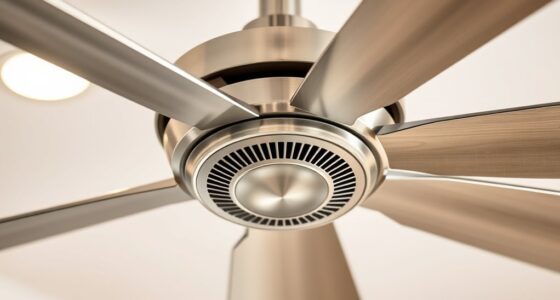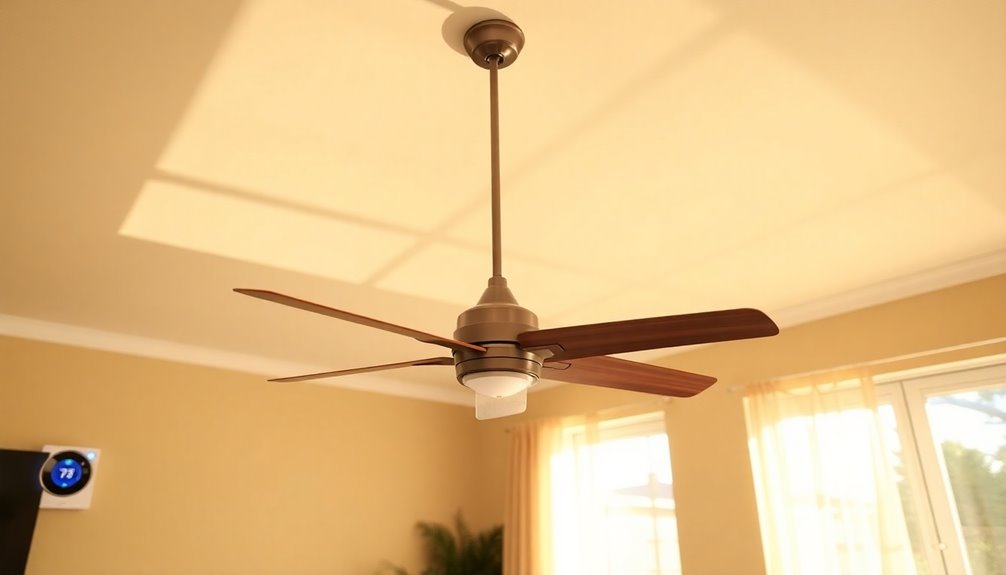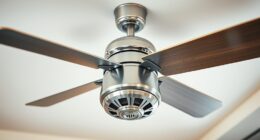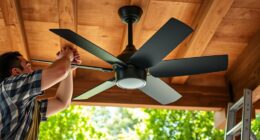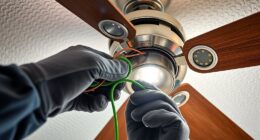Yes, a ceiling fan can fall, especially if it's not properly installed or maintained. If you notice your fan wobbling, that's a sign of potential installation issues or loose components, which can increase the risk of it detaching. Using the right mounting hardware and securing all parts is essential for safety. Regular inspections can help you catch any loose screws or wear before they lead to accidents. Always verify your fan is mounted securely to a fan-rated junction box and keep an eye on any signs of instability to prevent falls. There's more to take into account for keeping your fan safe.
Key Takeaways
- A ceiling fan can fall if not properly installed or mounted using inadequate hardware, posing serious injury risks.
- Wobbling fans often indicate installation issues or loose components, increasing the likelihood of falling.
- Metal blade fans are particularly dangerous; falling blades can cause severe injuries.
- Regular maintenance and inspection of screws and connections are essential to prevent falls.
- Fans should be securely mounted to a fan-rated junction box and installed at a height of 2.1 meters for safety.
Ceiling Fan Safety Risks

When it comes to ceiling fan safety risks, how aware are you of the potential dangers? Ceiling fans can pose serious injury risks, especially if they're not properly installed or maintained.
If your fan wobbles, it may indicate an installation issue or that it's become loose over time, which could lead to accidents. Metal blade fans are particularly concerning; they can inflict severe injuries if they fall. Additionally, ensuring that your fan is properly aligned can help it operate quietly and efficiently, reducing the chance of accidents.
You should also be cautious if there are children in your home. Kids jumping from bunk beds can greatly increase the risk of accidents, especially when they're near ceiling fans.
Proper placement is essential—fans should be installed at a height of about 2.1 meters from the floor to minimize potential injury. Moreover, consider the fan's proximity to beds and play areas. If your fan is installed too close to these zones, you're inviting danger.
Awareness of where your fan is located and verifying it's securely fastened can make a substantial difference in keeping your home safe. By taking these precautions, you can reduce the likelihood of accidents and promote a safer environment for everyone. Regular maintenance, including checking installation guidelines, can help ensure your fan remains secure and effective.
Ensuring Fan Safety

Guaranteeing fan safety is vital for maintaining a secure environment in your home. To start, make certain your ceiling fan is installed properly, ideally at a height of 2.1 meters from the floor. This height reduces the risk of accidents and allows for peak airflow.
If you have low ceilings, consider using semi-flush mount fans, which help maintain a safe distance from the blades.
Another effective safety measure is to install guards on your ceiling fans. This is especially important in homes with children, as it greatly reduces the risk of accidental contact with the fan blades.
Additionally, be mindful of the fan's placement. Position your fan away from beds and other areas where people might jump or move unexpectedly, guaranteeing a safe distance from the blades.
Regular maintenance is also important for fan safety. Inspect your ceiling fan periodically, checking for loose screws or any signs of wear.
Tightening screws and performing routine checks will help maintain the fan's safety and performance, allowing you to enjoy its benefits without worry.
Causes of Fan Wobble

When your ceiling fan wobbles, it's often due to improper installation or loose components.
Bent blade holders and loose screws can throw the fan off balance, making it unstable during operation.
Addressing these issues is essential to guarantee your fan operates smoothly and safely.
Improper Installation Issues
Improper installation issues are one of the most common causes of ceiling fan wobble. When you don't install your ceiling fan correctly, it can lead to loosened mountings over time. This wobbling not only affects the fan's performance but also poses safety hazards.
If the blades are misaligned due to incorrect installation, you'll create uneven pressure levels, causing the fan to wobble during operation. Loose screws in the mounting bracket or blade holders can greatly contribute to a fan's instability.
Over time, these issues can escalate, and in the worst-case scenario, a poorly installed fan fell, causing potential injuries or damage. Regular inspections are essential to identify installation-related problems, like misaligned components or loose fittings, before they become serious hazards.
To guarantee your ceiling fan operates smoothly and safely, always follow installation guidelines. Secure screws to a solid wooden joist and double-check that everything is tightened properly.
Bent Blade Problems
Bent blades are a common culprit behind ceiling fan wobble, often leading to an unbalanced and noisy operation. You might experience a wobbly fan due to various causes related to bent blades, which can result from:
- Physical Impact: Hitting the blades accidentally while cleaning or moving furniture can cause bending.
- Improper Handling: Mishandling during installation or maintenance may lead to damage.
- Manufacturing Defects: Occasionally, blades may come bent from the factory, affecting performance.
- Wear and Tear: Over time, aging blades can warp, leading to imbalance.
If you notice your fan wobbling, it's essential to address any bent blades promptly. An unbalanced fan can lead to excessive stress on the motor and mounting hardware, potentially causing mechanical failure.
Regular maintenance checks, including inspecting blade alignment and replacing bent blades, can help maintain balance and reduce noise.
Ignoring bent blades could escalate the issue, resulting in loose screws or connections, heightening the risk of the fan falling.
Loose Mounting Components
Loose mounting components can greatly affect your ceiling fan's performance, leading to wobbling and potential safety hazards. Over time, vibrations can cause screws and bolts to loosen, creating instability. If you haven't inspected your fan recently, it's time to check for these issues. Improper installation, like not ensuring tight connections, also contributes to wobbling, increasing the risk of the fan to fall.
| Cause | Effect | Solution |
|---|---|---|
| Loose screws/bolts | Wobbly fan | Regularly inspect and tighten them |
| Bent blade holders | Imbalance in fan | Replace or realign blade holders |
| Poor installation practices | Increased fan movement | Use thread lock compounds on screws |
Preventing Ceiling Fan Falls

To guarantee your ceiling fan remains securely in place, proper installation is key.
First, always mount your fan to a fan-rated junction box. This guarantees the fan has adequate support and helps prevent falls.
Second, maintain a minimum height clearance of 2.1 meters from the floor to reduce the risk of accidental contact.
Third, consider utilizing safety features like safety wires or lag screws during installation. These elements enhance your fan's security and help prevent it from dislodging over time.
Finally, be mindful of your fan's placement; avoid positioning it too close to beds or high-traffic areas to further decrease the likelihood of accidents.
Here's a quick checklist to help you prevent falls:
- Install to a fan-rated junction box for proper support.
- Guarantee a clearance of 2.1 meters from the floor.
- Use safety wires or lag screws during installation.
- Position the fan wisely, keeping it away from high-traffic areas.
Repair and Maintenance Tips

To keep your ceiling fan safe and secure, you should regularly inspect and tighten all screws and connections.
Using proper installation techniques, like safety wires and fan-rated boxes, will greatly reduce the risk of a fall.
Don't forget to schedule periodic checks to make certain everything's functioning properly.
Regular Inspection Practices
Regular inspections of your ceiling fan are essential for ensuring safety and ideal performance. To keep your fan running smoothly and safely, follow these maintenance practices:
- Check for Loose Screws: Inspect the fan blades, brackets, and mounting hardware for any loose screws. Tightening them can prevent potential falls.
- Clean the Fan Blades: Dust buildup can affect the fan's balance and contribute to wobbling. Wipe the fan blades regularly to keep them clean and functioning well.
- Inspect Wiring and Connections: Examine the junction box and wiring for any signs of wear or loose connections. Identifying issues early can mitigate safety hazards.
- Frequency of Inspections: Conduct these inspections at least once a year. If your fan is used heavily or shows any signs of instability, check it more frequently. Regular maintenance can enhance home security systems by minimizing risks associated with falling fixtures.
Secure Installation Techniques
Proper installation techniques are just as important as regular inspections when it comes to guaranteeing the safety of your ceiling fan.
First, always use a fan-rated junction box. This type of box is designed to support the weight and motion of the fan, considerably reducing the risk of falls. During installation, make sure to secure the fan with safety wires or lag screws for additional security. This extra step helps prevent the fan from detaching from the ceiling. Additionally, using a high-quality fan can further enhance stability and performance.
Once installed, don't forget to regularly inspect and tighten all screws and connections, focusing on the mounting bracket and fan blades. Over time, vibrations can cause these components to loosen, which is a safety hazard.
To further enhance secure installation, consider applying a thread-locking adhesive, like Loctite, to the screws. This will minimize the chances of loosening due to constant movement.
Conduct routine maintenance checks every few months to guarantee everything remains secure and the fan operates smoothly. Additionally, ensure that the installation adheres to local fire safety regulations to prevent potential hazards.
Safety Features of Ceiling Fans

When it comes to ceiling fans, safety features play an essential role in preventing accidents and guaranteeing stability.
You'll want to look for specific elements that enhance safety, especially when installing indoor ceiling fans. Consider the following safety features:
- Safety Cables: Many fans come equipped with safety cables to prevent falls in case of hardware failure, particularly for heavier models.
- Secure Mounting Bracket: A mounting bracket designed to withstand operational forces is imperative. This prevents loosening over time.
- Threaded Rods and Locking Pins: Quality brands often use these additional features to enhance fan stability during use.
- Fan-Rated Junction Box: Proper installation guidelines recommend using a fan-rated junction box to guarantee secure mounting, reducing the risk of accidents.
Community Experiences and Feedback

Community feedback on ceiling fans often highlights real-life experiences that underscore the significance of safety features and proper installation. Many users have shared alarming stories of ceiling fans falling, primarily due to inadequate mounting hardware and poor installation practices.
It's essential to guarantee your fan is securely installed; otherwise, you risk serious accidents. Several community members emphasize the need to fasten screws tightly and use appropriate outlet boxes. When a fan isn't installed correctly, it can lead to devastating outcomes.
Some recommend incorporating safety wires or lag screws during installation to provide extra stability. These precautions can make a notable difference in preventing falls.
Regular maintenance checks also play a fundamental role in keeping your ceiling fan safe. Over time, components can loosen, and without routine inspections, you mightn't realize there's an issue until it's too late.
Additionally, you'll find varied opinions on different fan brands, with many users advocating for specific models praised for their reliable installation features and safety mechanisms.
Frequently Asked Questions
How Likely Is It for a Ceiling Fan to Fall?
When it comes to ceiling fans, you might wonder how likely it's for one to fall. The risk is low if you make sure it's installed properly.
Check for loose mountings or worn-out brackets, as these can increase the chance of accidents. Regular inspections and maintenance are key to keeping everything secure.
If you take these precautions, your ceiling fan should stay securely in place without any worries.
Can a Wobbly Ceiling Fan Possibly Fall?
A wobbly ceiling fan can potentially fall if it's not properly installed or maintained. While the risk is low, you should check the fan's mounting and verify it's secured to a sturdy joist.
Regularly inspecting and tightening screws can help prevent issues that cause wobbling. If you notice any unusual movement, it's best to address it immediately to avoid accidents.
Keeping your fan well-maintained guarantees safety and peace of mind.
How Safe Are Ceiling Fans?
Ceiling fans can be safe if installed and maintained properly.
You should guarantee they're installed at a height of at least 2.1 meters from the floor to avoid accidents, especially near beds or play areas.
Regular inspections can help identify any loose fixtures or wobbling, reducing risks.
If you have low ceilings, consider semi flush mount fans to enhance safety.
How Far Can You Drop a Ceiling Fan?
Imagine a ceiling fan gracefully spinning above your head, bringing a gentle breeze on a hot day.
When considering how far a ceiling fan can drop, it's essential to remember that it's designed to stay securely mounted. If installed correctly, it shouldn't fall at all.
However, if improperly secured or neglected, even a slight wobble can lead to disaster. Regularly check those screws and brackets to keep your space safe and serene.
Conclusion
As you sit beneath that ceiling fan, you can't help but wonder—could it really fall? The thought sends a chill down your spine. But by taking simple precautions and ensuring regular maintenance, you can keep your space safe and enjoy the gentle breeze without fear. Don't wait for a wobble or a creak to remind you; act now. A little vigilance today can save you from an unexpected disaster tomorrow. Stay safe under that spinning blade!
